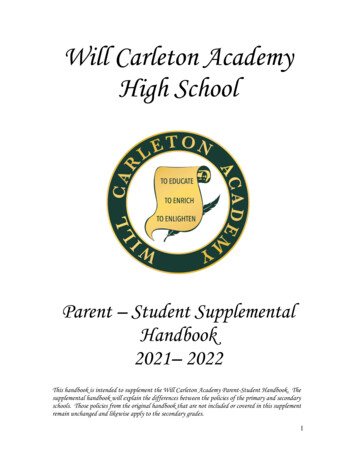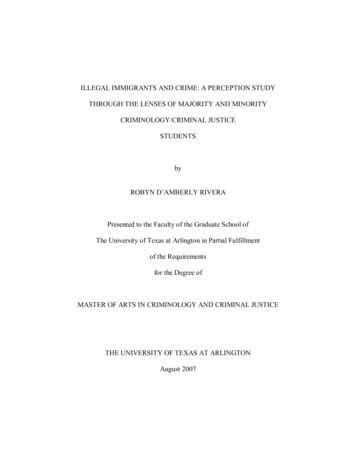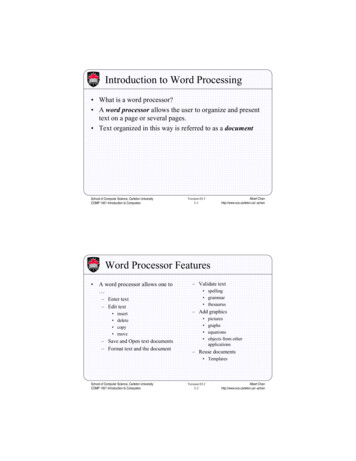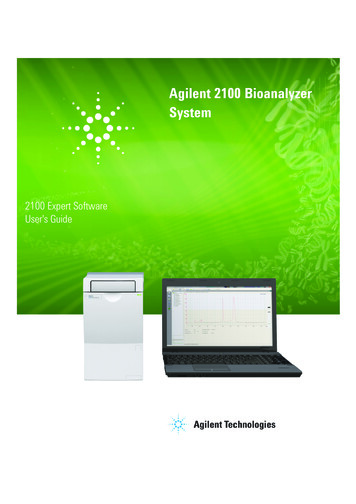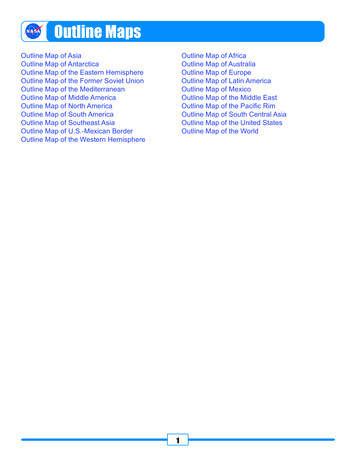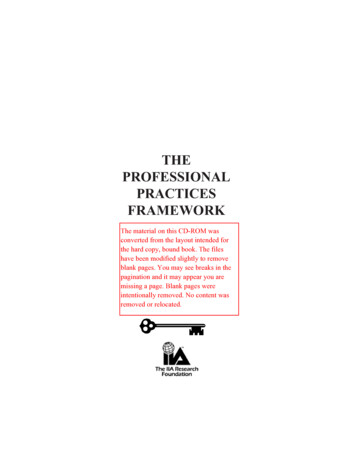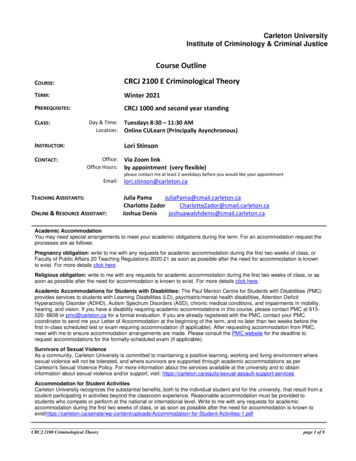
Transcription
Carleton UniversityInstitute of Criminology & Criminal JusticeCourse OutlineCOURSE:CRCJ 2100 E Criminological TheoryTERM:Winter 2021PREREQUISITES:CRCJ 1000 and second year standingCLASS:Day & Time:Location:INSTRUCTOR:CONTACT:Tuesdays 8:30 – 11:30 AMOnline CULearn (Principally Asynchronous)Lori StinsonOffice:Office Hours:Via Zoom linkby appointment (very flexible)please contact me at least 2 weekdays before you would like your appointmentEmail:TEACHING ASSISTANTS:ONLINE & RESOURCE ASSISTANT:lori.stinson@carleton.caJulia PamaJuliaPama@cmail.carleton.caCharlotte ZadorCharlotteZador@cmail.carleton.caJoshua Denisjoshuawalshdenis@cmail.carleton.caAcademic AccommodationYou may need special arrangements to meet your academic obligations during the term. For an accommodation request theprocesses are as follows:Pregnancy obligation: write to me with any requests for academic accommodation during the first two weeks of class, orFaculty of Public Affairs 20 Teaching Regulations 2020-21 as soon as possible after the need for accommodation is knownto exist. For more details click here.Religious obligation: write to me with any requests for academic accommodation during the first two weeks of class, or assoon as possible after the need for accommodation is known to exist. For more details click here.Academic Accommodations for Students with Disabilities: The Paul Menton Centre for Students with Disabilities (PMC)provides services to students with Learning Disabilities (LD), psychiatric/mental health disabilities, Attention DeficitHyperactivity Disorder (ADHD), Autism Spectrum Disorders (ASD), chronic medical conditions, and impairments in mobility,hearing, and vision. If you have a disability requiring academic accommodations in this course, please contact PMC at 613520- 6608 or pmc@carleton.ca for a formal evaluation. If you are already registered with the PMC, contact your PMCcoordinator to send me your Letter of Accommodation at the beginning of the term, and no later than two weeks before thefirst in-class scheduled test or exam requiring accommodation (if applicable). After requesting accommodation from PMC,meet with me to ensure accommodation arrangements are made. Please consult the PMC website for the deadline torequest accommodations for the formally-scheduled exam (if applicable).Survivors of Sexual ViolenceAs a community, Carleton University is committed to maintaining a positive learning, working and living environment wheresexual violence will not be tolerated, and where survivors are supported through academic accommodations as perCarleton's Sexual Violence Policy. For more information about the services available at the university and to obtaininformation about sexual violence and/or support, visit: servicesAccommodation for Student ActivitiesCarleton University recognizes the substantial benefits, both to the individual student and for the university, that result from astudent participating in activities beyond the classroom experience. Reasonable accommodation must be provided tostudents who compete or perform at the national or international level. Write to me with any requests for academicaccommodation during the first two weeks of class, or as soon as possible after the need for accommodation is known ds/Accommodation-for-Student-Activities-1.pdfCRCJ 2100 Criminological Theorypage 1 of 8
CALENDAR DESCRIPTIONComprehensive survey of the plurality of criminological theories, from phrenology to contemporarytheories concerned with issues related to crime and punishment. Students are encouraged to developcritical and reflexive thinking on various criminological issues and theories.COURSE OBJECTIVESThis class offers students a chance to explore to selected complimentary and contradictoryfoundational theoretical perspectives in criminology. As such it provides a basic introduction to thearray of theoretical tools, approaches and basic concepts crossing over a wide array of foundationaltheory in western contemporary criminology. We will pay particular attention to the place of theory inilluminating, making sense of and even producing and reproducing deviance, harm, crime, criminality,victims, justice and what are seen to be legitimate solutions to the ‘problem of crime.’ Do thesetheories, or tools for facilitating understanding and action, widen, curtail or obscure our field of visionand our ability to respond appropriately when problems appear to arise in society?In the interests of allowing students the opportunity to compare, contrast and test the veracity of thetheories presented the specific objectives of the course will be as follows:1. Situate the historical, social, political, economic, cultural and academic impetuses and contextsthrough which selected foundational theories have emerged, continued to flourish or not, andpotentially how they transform, change or grow2. Outline current applications of theories, including affected and involved communities,practices, and central concepts associated with each perspective3. Consider the sets of questions these theories seek to raise and respond to, and how or whythey frame and understand those questions as they do4. Interrogate the assumptions and explanations of crime, deviance and social control respectivetraditions present and advocate5. To assess how well these perspectives stand up to critical evaluation, comparison, contrast, andpractical criticism6. Potentially apply these conceptual and theoretical tools to the analysis of specificcontemporary issues in theory, policy and advocacyWe will also work on improving academic writing, referencing and citation skills in through completionof the introductory assignments, the case study, and the midterm and take-home exams.REQUIRED TEXT**Robert M. Bohm and Brenda L. Vogel (2015). A Primer on Crime and Delinquency Theory 4th edition.Durham NC: Carolina Academic Press.Other selected original source articles (including a few from The Sage Handbook of CriminologicalTheory) as listed on the outline and available via Ares through links for that purpose on CULearn; aswill be supplementary (not-required) texts**Hard and electronic copies of the text are available via Haven Books, 43 Seneca St, Ottawa, ON K1S4X2, (613) 730-9888.Any audio-visual materials (including lectures, documentaries, and audio recordings of live classmeetings) will be available via links within the module to which they pertain. An electronic copy of therequired text will also hopefully be made available on reserve through Ares.CRCJ 2100 Criminological Theorypage 2 of 8
SUPPLEMENTARY RESOURCESSome supplementary articles and online content, with a focus on news, science, policy, application andevaluation of the theoretical perspectives we will be examining will also be posted through links inindividual modules. Please note you will be able to incorporate these into your written work in additionto the required readings if you wish; however, they will not count as equivalent to the requiredreadings where assignments stipulate required readings.LEARNING STRATEGY & STRUCTUREThe class will be principally online and asynchronous, and organized into content modules. You will beable to watch and hear lectures and other audio-visual materials via content modules each focused ona different theoretical tradition in criminology. At regular intervals across the same modules you willfind quizzes (or knowledge checks) on the content of your required course readings and lectures. Yourmidterm and final exams will focus on short and/or long answer questions asking you to pulltogether what you are learning from completing the readings, lectures and other resources via themodular (weekly or bi-weekly) framework.The asynchronous modular format will be supplemented with live tutorial/discussion seminars viazoom focused on preparing you for doing your best on the larger assignments (the midterm, casestudy and take-home final). As you will notice on the course schedule they all take place before anexam, or when you receive case study assignment. In addition to answering any questions you mighthave on course content we will go over the requirements of the assignments with specifics on how toput your assignments together, how and how much to cite (always including page numbers), and whatto do to improve your written work and get better grades. For those who cannot attend the liveseminars a zoom audio only recording will be provided in the associated module by the following day,so no matter what you will still be able to listen to that and post any questions on the clarificationforum. The live classes (with audio recording posted afterwards) do not replace regular lectures,required readings or any other required content; they are just there to help you do better in being ableto use your course materials to produce your best work.Each module will contain the listing of the required readings from your text and original sourcearticles (the same as listed on your course schedule here), a series of associated lectures (via Kaltura),a power point deck outlining the content of the lectures, and at intervals a quiz on the content of therequired readings and lectures.Detailed instructions on how to complete any assignments or exams will be posted in the right side-barmenu of CULearn and attached to each assignment in the respective modules they arise. Lectures arepresented in a series for each module to make them more accessible and easier to go back to later ifneed be. You can also watch the lectures at your own pace – take breaks to stretch, get a drink orsomething to eat to help keep your focus up – online lectures will not be more exciting than live :)Some modules may also include audio-visual clips or documentaries to supplement your understandingof lectures and readings.The first ‘get acquainted’ module offers ways to build your grade while getting used to the onlineformat, the way the quizzes (knowledge checks) will work, and will check your knowledge on coursecontent as outlined in this syllabus, and academic essentials including the fundamentals of plagiarismand academic fraud (document provided to go over). The introductory module just gives you a markfor introducing yourself to your classmates, 2 marks for responding to questions on academic integrityCRCJ 2100 Criminological Theorypage 3 of 8
and plagiarism, and two marks for completing some true/false questions on content from the outlinewith emphasis on academic requirements – all for very easy marks just for getting acquainted withcourse requirements, the online quiz tools and format that will be used for the regular quizzes(knowledge checks) on the content, and briefly introducing yourself to your classmates.Each new module will open up on or before the date and time the class is scheduled for in theuniversity term calendar to help avoid overloading the university system with content all uploading atonce. As we progress through content the previous modules submission provisions will close.Remember it will be your responsibility to make sure to pay attention to activity and assignmentdeadlines; however, if you miss a deadline, don’t panic. Just contact me or your online assisting TA.In addition to the 5 marks for acquainting yourself with the course and your classmates with you, thereare 5 knowledge checks (5 marks each for a total of 25) on the content of your required readings andlectures, a short answer midterm knowledge check worth 20 marks) and a long answer take-homefinal exam worth 30 marks. The final exam will focus on content from after the midterm exam.Everyone is strongly encouraged to be active, thoughtful, and respectful participants and contributorsto the knowledge generated and shared in the virtual classroom over the course of the semester.EVALUATION(all components must be completed for a passing grade)Standing in a course is determined by the course instructor subject to the approval of the Faculty Dean.This means that grades submitted by the instructor may be subject to revision. No grades are final untilthey have been approved by the Dean, so final exam marks and grades cannot be released beforehand.COMPONENTS OF FINAL MARKEVALUATION FORMATIntroduce yourselfKnowledge check: Academic IntegrityKnowledge check: Course RequirementsKnowledge Check QuizzesMidterm Short Answer Questions posted Feb 23Central Park 5 Case StudyShort/Long Answer Take-home Final ExamWEIGHT1%2%2%(5 x 5 %) 25 %20 %20 %30 %DUE DATESJanuary 23January 23January 23Jan 30, Feb 13, Mar 13, 27, Apr 16February 26March 30April 26All due dates allow for submission up until 11:55 PM on the date listed.Detailed descriptions and rubrics are included in the relevant module on your CULearn course page.GRADINGGrades will generally be distributed according to the following template:A 90-100%A85-89%A-80-84%B 77-79%B73-76%B-70-72%C 67-69%C63-66%C-60-62%D 56-59%D53-56%D-50-52%FBelow 50CRCJ 2100 Criminological Theorypage 4 of 8
All your written work will be graded for insight, analytical skill, inclusion and organization of relevantcourse materials, appropriate academic form, references and appropriate citation (including pagenumbers), clarity of expression (logical flow, readability, grammar, correct word usage and spelling),accuracy and relevance of content. Poorly written work will be penalized, so please go through thematerials in the Introductory module on CULearn for detailed information on organizing, formatting,writing, correctly citating and referencing your work and for specifics on evaluation and grading.Late submissions and Missed Exams are not encouraged, although exceptions are made for illness orother challenging situations. Please contact your Lori or your engagement teaching assistant as quicklyas possible should you require accommodation on deadlines. Each day of late submission without anarranged extension may result in a penalty of 5% per day cumulative. University regulations requireabsences and late submissions on final exams be supported by documentation. Information and formsshould you require a formal final exam deferral are available sts/deferral/Always keep copies of all your written work submitted. Retain for yourself more than one copy inalternate formats (hard copy, external hard drive, or USB in addition to your original on your primarycomputer) of all essays, term papers, contributions to forums, take-home exams and any other writtenwork submitted in your courses.STATEMENT ON PLAGIARISMThe University Senate defines plagiarism as “presenting, whether intentionally or not, the ideas,expression of ideas or work of others as one’s own.” This can include: reproducing or paraphrasing portions of someone else’s published or unpublished material,regardless of the source, and presenting these as one’s own without proper citation includingpage numbers, or reference to the original source;submitting a take-home examination, essay, laboratory report or other assignment written, inwhole or in part, by someone else;using ideas or direct, verbatim quotations, or paraphrased material, concepts, or ideas withoutappropriate acknowledgment (citations including page numbers) in any academic assignment;using another’s data or research findings;failing to acknowledge sources through the use of improper citations when using another’sworks and/or failing to use quotation marks;handing in "substantially the same piece of work for academic credit more than once withoutprior written permission of the course instructor in which the submission occurs."Plagiarism is a serious offence that cannot be resolved directly by the course’s instructor. TheAssociate Dean of the Faculty conducts a rigorous investigation, including an interview with thestudent, when an instructor suspects a piece of work has been plagiarized. Penalties are not trivial.They can include a final grade of "F" for the course.INTELLECTUAL PROPERTYClassroom teaching and learning activities, including lectures, discussions, presentations, etc., by bothinstructors and students, are copy protected and remain the intellectual property of their respectiveauthor(s). All course materials, including PowerPoint presentations, outlines, and other materials, arealso protected by copyright and remain the intellectual property of their respective author(s).CRCJ 2100 Criminological Theorypage 5 of 8
Students registered in the course may take notes and make copies of course materials for their owneducational use only. Students are not permitted to reproduce or distribute any lecture notes,recordings or any other course materials publicly for commercial or non-commercial purposeswithout express written consent from the copyright holder(s).Email to Professor or TA: Where needed emails should receive a response within two business days.Please keep time constraints in mind when emailing for virtual appointments or questions onassignments. Emails should not include questions already addressed on the course outline or CULearn,requests for ‘extra credit assignments,’ or whether required readings are required (they are).Virtual Campus: For any technical difficulties, questions or problems with any of Carleton’s virtuallearning and management platforms contact the system support folks immediately responsible for therespective systems (via help links on respective pages or general main page help listings).CLASS SCHEDULEPlease complete your required readings and lectures within the dates of the module for which they arelisted, and assignments by the dates they are indicated as due in ‘Components of Final Mark’.DATETOPICSASSIGNMENTS (indicated by bullets) & REQUIRED READINGSModule 1January 12Introduction toCourse Essentials,Assignments, &Cross modulethemesWelcome to Criminological TheoriesRead: Course Outline & Statement on Academic IntegrityPeruse: Writing Resources Folder & Communication Forums Introduce Yourself Knowledge Check on course outline and requirements Knowledge Check on academic standards including plagiarismWhy Theory?Why theorizecrime & deviance?Module 2January 19Module 3January 26Bohm, R.M. & Vogel, B.L. (2015). Chapter 1: An Introduction toTheory. In A Primer on Crime and Delinquency Theory 4th ed., 3-18.Classical,Neoclassical &Positivist TheoryBohm, R.M. & Vogel, B.L. (2015). Chapter 2: Classical & NeoclassicalTheory. In A Primer on Crime and Delinquency Theory 4th ed., 19-32.Biology,Ideology& ScienceBohm, R.M. & Vogel, B.L. (2015). Chapter 4: Biological Theories. In APrimer on Crime and Delinquency Theory 4th ed., 43-66.Bohm, R.M. & Vogel, B.L. (2015). Chapter 3: Positivist Theories. APrimer on Crime and Delinquency Theory 4th edition, 33-42.Baker, L.A., Tuvblad, C. & Raine, A. (2010). Genetics and Crime. In TheSage Handbook of Criminological Theory, 21-39. Module 4February 2Psychology,Psychoanalytics,Personality &HumanismCRCJ 2100 Criminological TheoryModule 1-3 QuizBohm, R.M. & Vogel, B.L. (2015). Chapter 5: Psychological Theories. InA Primer on Crime and Delinquency Theory 4th ed., 67-90.Farrington, D.P. (2010). Life-Course and Developmental Theories inCriminology. In The Sage Handbook of Criminological Theory, 249270.page 6 of 8
Module 5February 9[LIVE zoomdiscussion onmidterm10:00 AM]Audio tine Activities,Anomie & StrainChamard, S. (2010). Routine Activities. In The Sage Handbook ofCriminological Theory, 210-224. February 16Midterm BreakModule 6February 23MIDTERM EXAMModule 7March 2Bohm, R.M. & Vogel, B.L. (2015). Chapter 6: MacrosociologicalTheory. In A Primer on Crime and Delinquency Theory 4th ed., 91120.Social Learning,Subculture,and Social ControlModule 4-5 QuizBohm, R.M. & Vogel, B.L. (2015). Chapter 7: MicrosociologicalTheories. In A Primer on Crime and Delinquency Theory 4th ed., 121144.Hallsworth, S. & Young, T (2010). Street Collectives and GroupDelinquency: Social Disorganization, Subcultures and Beyond. InThe Sage Handbook of Criminological Theory, 72-95.Module 8March 9[LIVE zoomdiscussion onCase Study10:00 AM]Audio postedafterwardsModule 9March 16Social ReactionTheory:Interactionism,LabellingFilm: The CentralPark Five (2014)120 mins.(subject of casestudy)Conflict,Radical,& Left RealistCriminologyBohm, R.M. & Vogel, B.L. (2015). Chapter 8: Critical Theories: Origins,Interactionalism & Labelling. In A Primer on Crime and DelinquencyTheory 4th ed., 145-151.Muncie, J. (2010). Labelling, Social Reaction and SocialConstructionism. In The Sage Handbook of Criminological Theory,139-152.Jefferson, T. (2014) Exploring the continuing relevance of Policing theCrisis. City 18(2): 152-159. Module 7-8 QuizBohm, R.M. & Vogel, B.L. (2015). Chapter 8: Critical Theories: Conflict,Radical, Left Realist Criminologies. In A Primer on Crime andDelinquency Theory 4th ed., 152-163 & 167-168.Bohm, R. (1982) Radical Criminology: An Explication. In Criminology 19(4) February: 565-589.Young, J. (1988) Radical Criminology in Britain: The Emergence of aCompeting Paradigm. British Journal of Criminology 28(2): 159-183CRCJ 2100 Criminological Theorypage 7 of 8
Module 10March 23Feminist &PeacemakingCriminologiesFilm: Repairingthe Harm:Restorative Justice(2007) 30 mins.Bohm, R.M. & Vogel, B.L. (2015). Chapter 8: Critical Theories: Feminist& Peacemaking Criminologies. In A Primer on Crime andDelinquency Theory 4th ed., 164-167 & 168-169.Daly, K. & Chesney-Lind, M. (2002) Feminism and Criminology. JusticeQuarterly 5(4): 497-538.Pepinsky, H. (2013) Peacemaking Criminology. Critical Criminology 21:319-339. Module 11March 30Post-structural,Constitutive,cultural &GovernmentalCriminologyModule 9-10 QuizBohm, R.M. & Vogel, B.L. (2015). Chapter 8: Critical Theories: Conflict,Radical, Left Realist, Feminist & Peacemaking Criminologies. In APrimer on Crime and Delinquency Theory 4th ed., 169-173.Ferrell, J. (2010) Cultural Criminology: The Loose Can[n]on. In TheSage Handbook of Criminological Theory, 303-318.O’Malley, P. (2010). Governmental Criminology. In The Sage Handbookof Criminological Theory, 319-336. Module 12April 6Rural, Convict,Queer, Global &EcologicalCriminologiesCentral Park 5 Case Study DueBohm, R.M. & Vogel, B.L. (2015). Chapter 8: . In A Primer on Crimeand Delinquency Theory 4th ed., 173-179.Aas, K.F. (2010) Global Criminology. In The Sage Handbook ofCriminological Theory, 427-446.Nurse, A. (2016) An Introduction to Green Criminological Theories. InAn Introduction to Green Criminology and Environmental Justice.London: Sage Books, 2-21.Module 13April 13[LIVE zoomdiscussion ontake-homefinal exam10:00 AM]April 26Critique,Conclusion &Looking forward:Integrated,Developmental, &Critical Realism?Bohm, R.M. & Vogel, B.L. (2015). Chapter 9: Integrated Theories,Developmental Theories and Beyond. In A Primer on Crime andDelinquency Theory 4th ed., 187-206.Matthews, R. (2010). Realist Criminology Revisited. In The SageHandbook of Criminological Theory, 193-209. Module 11-13 QuizTAKE-HOME LONG ANSWER FORMAT FINAL EXAM DUECRCJ 2100 Criminological Theorypage 8 of 8
As a community, Carleton University is committed to maintaining a positive learning, working and living environment where . A Primer on Crime and Delinquency Theory 4th edition. Durham NC: Carolina Academic Press. . (via Kaltura), a power point deck outlining the content of the lectures, and at intervals a quiz on the content of the .


